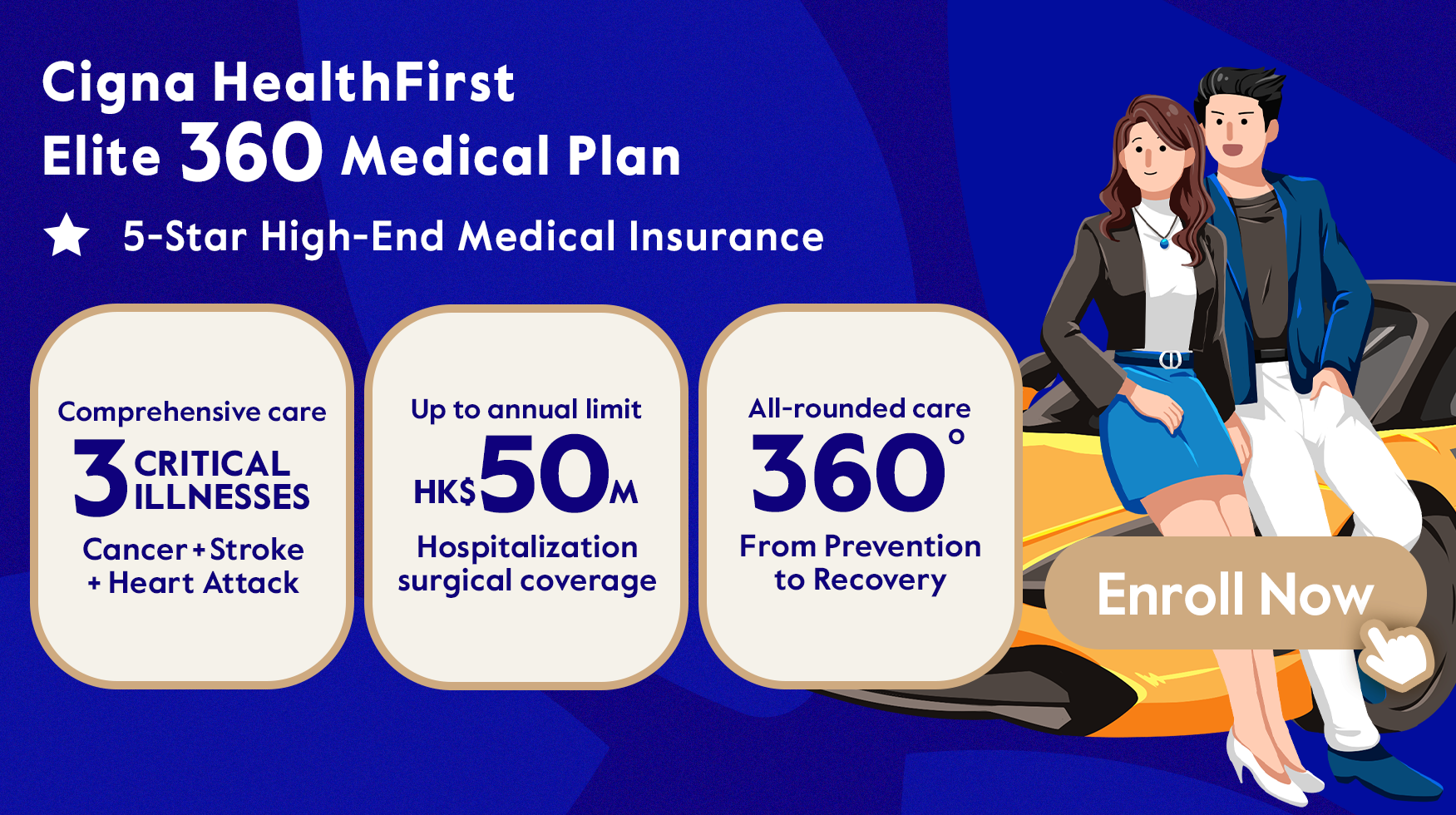Blood cancer or leukemia may sound scary, but it has the highest recovery rate among all types of cancers. With suitable treatment, the chance of surviving leukemia is 60 per cent on average. Blood cancer is one of the top 10 fatal cancers in Hong Kong, with around 1000 new cases found annually. However, it is worth noting that leukemia is a health risk for people of all ages.
What is Leukemia or Blood Cancer?
There are three types of blood cells circulating in the blood, red blood cells (transport oxygen), platelets (help blood clotting) and white blood cells (fight against infection). When the white blood cells divide too quickly and eventually crowd out the normal cells, the other blood cells and organs cannot function normally. This abnormality is called leukemia.
Types of Blood Cancer
Leukemia is grouped based on the type of blood stem cells they developed from and how quickly the leukemia grows. There are four main types, as shown below.
Both adults and children can suffer from a blood cancer that children are more prone to Acute Lymph-Blastic Leukemia (ALL). Clinically, leukemia can be divided into acute and chronic leukemia.
| Types of Leukemia |
Causes |
High-Risk Groups |
5-Year Survival Rate |
| Acute Lymph-Blastic Leukemia (ALL) |
ALL is a type of cancer in which the bone marrow makes too many immature lymphocytes (a type of white blood cell) that lower the number of normal blood cells and weaken one’s immunity quickly. |
Children, peak incidence at 4 year olds |
30% |
| Acute Myeloid Leukemia (AML) |
AML develops from abnormal myeloid stem cells or called immature lymphocytes. The immature cells proliferate in the bone marrow and spread to other vital organs, causing high risks of bleeding, bacterial infection and anemia. |
Adults aged over 50 |
26% |
| Chronic Lymphocytic Leukemia (CLL) |
CLL starts in abnormal lymphoid stem cells. It is called chronic because it usually develops slowly over months or years without any symptoms. It is also called chronic lymphoid leukemia. |
Adults aged over 50 |
85% |
| Chronic Myelogenous Leukaemia (CML) |
CML starts in abnormal myeloid stem cells. It is called chronic because it develops slowly without apparent symptoms. The abnormal myeloid stem cells develop into cancerous (malignant) granulocytes. |
Children, peak incidence at 40 year olds |
90% |
Symptoms of Leukemia
Symptoms of leukemia vary according to the type of leukemia. Chronic leukaemia does not usually cause any symptoms at an initial stage. It is usually found during routine blood tests.
Common symptoms of leukemia include:
- Fatigue and weakness that don’t go away with rest
- Bruising easily
- Bleeding easily
- Fever or chills
- Frequent infections
- Bone and joint pain
- Headache
- Vomiting
- Seizures
- Loss of appetite and unintentional weight loss
- Persistent fever
- Shortness of breath
- Painless, swollen lymph nodes (especially in the neck and armpits)
Causes of Leukemia
The exact causes of leukemia remain poorly understood. Leukemia is thought to begin with one abnormal chromosome which leads to genetic mutation and results in the overgrowth of white blood cells or immature lymphocytes in the bone marrow.
Besides, the following factors may increase the risk of leukemia.
- Smoking
- Exposure to excessive radiation
- Prior radiotherapy and chemotherapy treatment
- Congenital diseases, such as Down syndrome
- Family history of leukemia
How Is Leukemia Diagnosed?
If leukemia is suspected from the history and physical examination, your doctor will arrange the following tests for you:
| Tests for Leukemia |
Principles |
Reference Fees for Diagnosing Leukemia (HKD)* |
| Complete Blood Count |
A blood sample is collected and examined for the quantity of red cells, platelets, white cells, and leukemic cells. |
|
| Bone Marrow Aspiration and Biopsy |
Bone marrow aspiration and biopsy are procedures to collect bone marrow blood and a small piece of bone by inserting a special needle into the patient's hip bone. The sample is inspected under a microscope to observe any abnormalities. Pain is felt during sample collection. |
|
| Chromosome or Molecular Testing |
These are special testing performed in peripheral blood and bone marrow blood samples to detect abnormal changes in chromosome, DNA or tumor markers associated with leukemia. |
|
| Lymph Node Biopsy |
The lymph node or a portion of the lymph node is removed as a core biopsy to observe the conditions and diagnose chronic leukemia. |
|
| Radiography |
The test looks at the spleen and liver to see if they are larger than usual or enlarged. It can also be used to check if lymph nodes around the heart, near the trachea (windpipe) or in the back of the abdomen are enlarged. |
Full-body CT Scan: ~$12,000 - $18,000 |
| Lumbar Puncture (Spinal Tap) |
The test Inserts a thin needle between the vertebrae of your lower back. This allows your doctor to collect spinal fluid and determine if cancer has spread to the central nervous system. Pain is incurred during sample collection, which requires a few days to recover. |
*Prices as of 10 Apr 2021; Reference from the charges of local private hospitals and Hospital Authority.
Treatments of Leukemia
There are three types of leukemia treatments as listed in the table below. Your doctors may prescribe different dosages and cycles treatments per your conditions, so the fees vary among patients. The following prices are for your reference only.
| Treatments of Blood Cancer |
Principles |
Reference Fees for Treating Blood Cancer (HKD)* |
| Chemotherapy | Chemotherapy drugs are injected into a vein so that they enter the bloodstream and travel throughout the body to destroy blood cancer cells. This is also the primary treatment of leukemia. |
Application and preparation costs: $2,400 per day; chemotherapy drugs are charged separately at cost. |
| Haematology and Hematopoietic Stem Cell Transplant | A stem cell transplant infuses healthy blood-forming stem cells into the recipient’s body. Stem cells may be collected from a donor’s bone marrow, circulating blood and umbilical cord blood. |
Single donor platelet collection: $6,580 Leukapheresis: $6,580 |
| Target and destroy specific cancer cells with less damage posed on the normal cells nearby. Targeted therapy drugs for leukemia: Dasatinib, imatinib, nilotinib, rituximab |
Average monthly targeted drug cost: $45,300 - $71,200 |
*Prices as of 10 Apr 2021; Reference from the charges of local private hospitals and Hospital Authority.
| Types of Leukemia |
Major Treatments |
| Acute Lymph-blastic Leukemia (ALL) |
|
| Acute Myeloid Leukemia (AML) |
|
| Chronic Lymphocytic Leukaemia (CLL) |
|
| Chronic Myelogenous Leukaemia (CML) |
|
Dietary Advice for Leukemia Patients
Having a healthy diet is particularly important for blood cancer patients and the recovered. Leukemia & Lymphoma Society suggests including the food options below to achieve a balanced diet and raise immunity.
- Five to ten portions of fruits and vegetables
- Whole grains and legumes
- Low-fat protein foods, such as fish, lean meats and poultry
- Low-fat dairy foods
Ideally, you should include at least one type of cruciferous vegetables among your daily intake of vegetables, such as:
- Kale
- Spinach
- Broccoli
- Brussels sprouts
- Cabbage
- Watercress
According to the National Cancer Institute of the United States, cruciferous vegetables are nutritious as the major source of vitamins, minerals, and carotenoid. They are also anti-cancer and help inactivate carcinogens and protect cells from DNA damage.
Cigna HealthFirst Elite 360 Medical Plan offers comprehensive and personalized medical coverage across the stage prevention, diagnosis, treatment and recovery, with a range of hospital and surgical benefits, optional insurance benefits with an annual limit of up to HK$50 million, personalized health assessment, three critical illnesses(cancer, stroke and heart attack) all-rounded care and international medical concierge service. A 360-degree total health protection that spans across all the key stages of your health journey. Learn more here.
Sources:
© Cigna Healthcare 2023
Information provided in this article is intended for health and fitness purposes only and is not intended for use in the diagnosis of disease or other conditions, or in the cure, mitigation, treatment or prevention of disease (see Terms & Conditions for details). Any health-related information found in this article is available only for your interest and should not be treated as medical advice. Users should seek any medical advice from a physician, especially before self-diagnosing any ailment or embarking on any new lifestyle or exercise regime. Any information contained in this article may not be suitable, accurate, complete or reliable. Cigna Healthcare accepts no responsibility for the content or accuracy of information contained on external websites or resources, or for the security and safety of using them. "Cigna Healthcare" and the "Tree of Life" logo are registered trademarks of Cigna Intellectual Property, Inc. in the United States and elsewhere, licensed for use. All products and services are provided by or through operating subsidiaries, and not by The Cigna Group.




